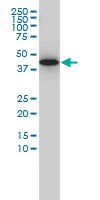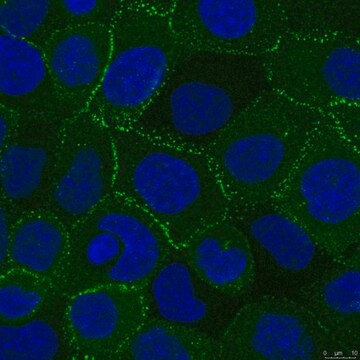推荐产品
生物源
mouse
品質等級
抗體表格
purified antibody
抗體產品種類
primary antibodies
無性繁殖
6F6-B5, monoclonal
形狀
liquid
不包含
preservative
物種活性
human
製造商/商標名
Calbiochem®
儲存條件
OK to freeze
avoid repeated freeze/thaw cycles
同型
IgG1
運輸包裝
wet ice
儲存溫度
−20°C
目標翻譯後修改
unmodified
基因資訊
human ... GNA13(10672)
一般說明
Anti-GNA13, mouse monoclonal, clone 6F6-B5, recognizes the ~40-45 kDa GNA13 protein in HepG2 cells. It is validated for use in ELISA and Western blotting.
Purified mouse monoclonal antibody. Recognizes the ~40-45 kDa GNA13 protein.
Recognizes the ~40-45 kDa GNA13 protein in HepG2 cells.
免疫原
Full-length, recombinant, human GNA13 (aa 1-378), expressed as a GST fusion protein
應用

ELISA (see comments)
Immunoblotting (1-5 g/ml)
警告
Toxicity: Regulatory Review (Z)
外觀
In PBS, pH 7.2.
重構
Following initial thaw, aliquot and freeze (-20°C).
分析報告
Negative Control
293T cells
293T cells
Positive Control
HepG2 cells
HepG2 cells
其他說明
For ELISA, this antibody can be used as the capture antibody; recommended concentration is 10 ng/ml, 1 µg/well, 100 µl total volume. Variables associated with assay conditions will dictate the proper working dilution.
法律資訊
CALBIOCHEM is a registered trademark of Merck KGaA, Darmstadt, Germany
未找到合适的产品?
试试我们的产品选型工具.
儲存類別代碼
12 - Non Combustible Liquids
水污染物質分類(WGK)
nwg
閃點(°F)
Not applicable
閃點(°C)
Not applicable
Suhail Ahmed Kabeer Rasheed et al.
The Journal of biological chemistry, 288(11), 7986-7995 (2013-01-19)
G protein-coupled receptors (GPCRs) and their ligands have been implicated in progression and metastasis of several cancers. GPCRs signal through heterotrimeric G proteins, and among the different types of G proteins, GNA12/13 have been most closely linked to tumor progression.
Suhail Ahmed Kabeer Rasheed et al.
Oncogene, 37(10), 1340-1353 (2017-12-20)
Treatment failure in solid tumors occurs due to the survival of specific subpopulations of cells that possess tumor-initiating (TIC) phenotypes. Studies have implicated G protein-coupled-receptors (GPCRs) in cancer progression and the acquisition of TIC phenotypes. Many of the implicated GPCRs
我们的科学家团队拥有各种研究领域经验,包括生命科学、材料科学、化学合成、色谱、分析及许多其他领域.
联系技术服务部门